

BBC Science Club - Music. Magnets & Magnetism for kids. All About Magnetism and How it Works - Easy Science For Kids. From your clothes to your desk, every bit of matter is made of tiny particles called atoms.
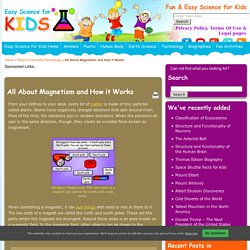
Atoms have negatively charged electrons that spin around them. Most of the time, the electrons spin in random directions. When the electrons all spin in the same direction, though, they create an invisible force known as magnetism. All About Magnetism: The two ends of a magnet are called the north and south poles. When something is magnetic, it can pull things with steel or iron in them to it. Magnet Attracts metals like iron or steel. The Earth is a very big magnet.
A compass has a tiny magnet in it. Learn More All About Magnetism and How It Works Around magnet poles is an area known as a magnetic field. Bill Nye - Magnetism (edited) Make A Periscope! Science Activity: Make a Periscope. What kinds of mirrors can I use to make a periscope?
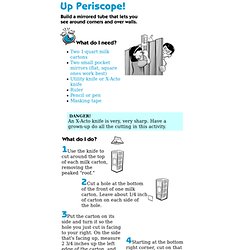
You need two small mirrors, but they don't have to be identical. If you have a rectangular mirror, or one with a handle, it's okay if part of it sticks out the side of the carton. If your mirror is round, like the mirror in a make-up compact, you may want to tape or glue it to a square of cardboard before inserting it into the slot in the milk carton. Make a Kaleidoscope - HowStuffWorks.
A kaleidoscope is an ideal science project that teaches kids how to reflect the spectrum of colors and make beautiful images.
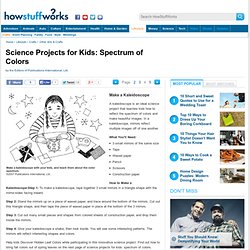
In a kaleidoscope, mirrors reflect multiple images off of one another. What You'll Need:3 small mirrors of the same sizeTapeWaxed paperPencilScissorsConstruction paper How to Make a Kaleidoscope:Step 1: To make a kaleidoscope, tape together 3 small mirrors in a triangle shape with the mirror-sides facing inward. Step 2: Stand the mirrors up on a piece of waxed paper, and trace around the bottom of the mirrors. Cut out this triangle shape, and then tape the piece of waxed paper in place at the bottom of the 3 mirrors. Step 3: Cut out many small pieces and shapes from colored sheets of construction paper, and drop them inside the mirrors. Step 4: Give your kaleidoscope a shake, then look inside. Help kids Discover Hidden Leaf Colors while participating in this innovative science project. Looking for more science projects to do with your kids?
Kaleidoscope Facts, information, pictures. The kaleidoscope makes magic with light and mirrors.
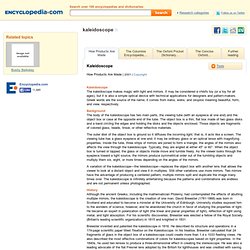
It may be considered a child's toy (or a toy for all ages), but it is also a simple optical device with technical applications for designers and pattern-makers. Greek words are the source of the name; it comes from kalos, eidos, and skopios meaning beautiful, form, and view, respectively. Background. Lesson 007. Sound Uncovered. Color Uncovered. Breaking glass with sound - Science (9) - ABC Splash - Wave energy securing airports - Science (9) - ABC Splash - Overview Electromagnetic radiation is energy that travels in waves.

Some examples include gamma rays, X-rays, microwaves and radio waves. Watch this clip to learn more about the properties of energy waves, such as wavelengths, and how electromagnetic radiation is being used in airport security to see through people's clothes but not their bodies. Why the sperm whale has a huge head. Credit: Illustration by Snip Green White waiters shaped like street lamps wheel softly between the tables, never spilling a drop of soup or wine.
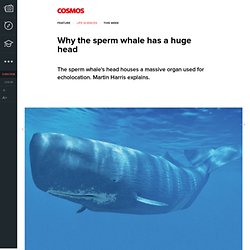
What is electricity - Ausgrid. Conduction of heat - Elementary Science. Www.wecanchange.com/sites/wecanchange.com/files//pdf/Grade Level 3- Energy.pdf. How to Start a Fire Without Matches. Insulation Experiment: Keep Your Body Warm. Ever wonder why your mom makes you wear two or three layers of clothing when you want to go outside and build a snowman?

These clothes are actually great insulators, which mean they're made from materials that keep your body temperature from dropping. In this insulation experiment, you'll learn which fabrics help keep you warm on an icy winter day. Some weather conditions, such as rain, wind, and snow cause our bodies to lose heat. If you don't select the right materials to keep your body warm and toasty, you'll start to shiver from the cold.
Wearing warm, insulating clothes allows you to stay outside even longer, having snowball fights with your friends, creating snow angels, and building igloos to play in. Problem: Which type of fabric insulates heat the best? Materials: 7 glasses of the same size and shape Water Thermometer Wool Cotton Denim Lace Fleece Nylon Kitchen timer Notebook and pencil. Misconceptions About Temperature. Colorful Convection Currents. Fill two bottles with warm water from the tap and the other two bottles with cold water.

Use food coloring or the Fizzers coloring tablets to color the warm water yellow and the cold water blue. Each bottle must be filled to the brim with water. Hot over cold: Place the index card or old playing card over the mouth of one of the warm water bottles. Hold the card in place as you turn the bottle upside down and rest it on top of one of the cold water bottles.